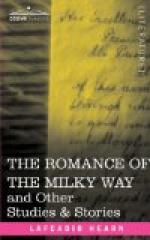As for the forty-odd tanka which I have translated, their chief attraction lies, I think, in what they reveal to us of the human nature of their authors. Tanabata-tsum[’e] still represents for us the Japanese wife, worshipfully loving;—Hikoboshi appears to us with none of the luminosity of the god, but as the young Japanese husband of the sixth or seventh century, before Chinese ethical convention had begun to exercise its restraint upon life and literature. Also these poems interest us by their expression of the early feeling for natural beauty. In them we find the scenery and the seasons of Japan transported to the Blue Plain of High Heaven;—the Celestial Stream with its rapids and shallows, its sudden risings and clamourings within its stony bed, and its water-grasses bending in the autumn wind, might well be the Kamogawa;—and the mists that haunt its shores are the very mists of Arashiyama. The boat of Hikoboshi, impelled by a single oar working upon a wooden peg, is not yet obsolete; and at many a country ferry you may still see the hiki-fun[’e] in which Tanabata-tsum[’e] prayed her husband to cross in a night of storm,—a flat broad barge pulled over the river by cables. And maids and wives still sit at their doors in country villages, on pleasant autumn days, to weave as Tanabata-tsum[’e] wove for the sake of her lord and lover.
* * * * *
—It will be observed that, in most of these verses, it is not the wife who dutifully crosses the Celestial River to meet her husband, but the husband who rows over the stream to meet the wife; and there is no reference to the Bridge of Birds.... As for my renderings, those readers who know by experience the difficulty of translating Japanese verse will be the most indulgent, I fancy. The Romaji system of spelling has been followed (except in one or two cases where I thought it better to indicate the ancient syllabication after the method adopted by Aston); and words or phrases necessarily supplied have been inclosed in parentheses.
Amanogawa
Ai-muki tachit[’e],
Waga ko[:i]shi
Kimi kimasu nari
Himo-toki mak[’e]na!
[He is coming, my long-desired
lord, whom I have been waiting
to meet here, on the banks
of the River of Heaven.... The
moment of loosening my girdle
is nigh![7]]
[Footnote 7: The last line alludes to a charming custom of which mention is made in the most ancient Japanese literature. Lovers, ere parting, were wont to tie each other’s inner girdle (himo) and pledge themselves to leave the knot untouched until the time of their next meeting. This poem is said to have been composed in the seventh year of Y[=o]r[=o],—A.D. 723,—eleven hundred and eighty-two years ago.]
Hisakata no[8]
Ama no kawas[’e] ni,
Fun[’e] uk[’e]t[’e],
Koyo[:i] ka kimi ga
Agari kimasan?




